摘要: 实验通过朗缪尔探针辅助激光诱导解离技术对27.12 MHz驱动的不同含氧量条件下容性耦合Ar等离子体进行了诊断研究. 通过质量流量计改变通入Ar与O
2 的流量以得到不同含氧量的等离子体. 结果表明, 由于氧气的分解吸附反应需要消耗电子, 致使朗缪尔探针测得的电子能量概率函数(EEPF)的中能部分随着含氧量的上升而下降. 射频输入功率增加时电子密度的上升引起了电子-电子碰撞热化, 从而使EEPF由Druyvesteyn分布向麦克斯韦分布转变. 在功率电极附近, 由于鞘层边界附近的电子氧气分子碰撞时的分解吸附反应使得鞘层区附近的负离子密度较高. 另外, 负离子密度沿着轴向呈现勺型分布的特征. 这主要是由于负离子在双极电场作用下向等离子体放电中心扩散的过程中所存在的负离子产生与损失的反应过程导致.
关键词: 激光诱导解离技术 /
朗缪尔探针 /
电负性等离子体 /
电负度 English Abstract Axial diagnosis of radio-frequency capacitively coupled Ar/O2 plasma Cao Li-Yang Ma Xiao-Ping Deng Li-Li Lu Man-Ting Xin Yu Provincial Key Laboratory of Thin Films, School of Physical Science and Technology, Soochow University, Suzhou 215006, China Fund Project: Project supported by the National Natural Science Foundation of China (Grant Nos. 11675117, 11175127) and the Priority Academic Program Development (PAPD) of Jiangsu Higher Education Institutions, ChinaReceived Date: 12 December 2020Accepted Date: 24 January 2021Available Online: 27 May 2021Published Online: 05 June 2021Abstract: The capacitively coupled Ar plasma containing oxygen, driven by a radio frequency of 27.12 MHz, is investigated by laser-induced photo-detachment technique assisted with a Langmuir probe. The plasmas with different amounts of oxygen are obtained by changing the flow of Ar and oxygen, each of which is controlled by a mass flow controller. The axial distribution of plasma characteristic can be measured by changing the relative axial position of the Langmuir probe between the parallel electrodes. The electron density and electron temperature are calculated from the current-voltage curve measured by the scanning Langmuir probe, and the electronegativity is obtained from the current curves of the probe with the laser-induced photo-detachment technique. The negative ion density can be calculated from the electron density and the electronegativity. It is shown that with oxygen flow rate increasing, the dissociative attachment of oxygen molecules with electrons will consume the electrons with the middle energy in the electron energy probability function (EEPF) measured by Langmuir probe. The EEPF evolves from Druyvesteyn to Maxwellian distribution due to the thermalization by the e-e interaction with applied power increasing. It is worth mentioning that a depression in the EEPF curve will appear when discharging high-pressure Ar gas containing oxygen. This depression can also be caused by the dissociative attachment of oxygen molecules with electrons where the threshold energy is around 4.5 eV. The axial profile of the electron density is calculated from the EEPF changing from a linear rise in pure Ar plasma to a flater phase of the distribution due to the negative ions such as oxygen introduced into the plasma. The electron temperature changes a little at different axial positions. The rise of negative ion density nearby the sheath of powered electrode is due to the dissociative attachment caused by the collision of oxygen molecules with energetic electrons. In addition, the axial distribution of electronegativity takes on a shape of spoon, which results from the consequence of generation and loss of negative ions in the process of the ambipolar-electric-field-driven diffusion to the plasma center.Keywords: laser induced photo-detachment /Langmuir probe /electronegative plasma /electronegativity 全文HTML --> --> --> 1.引 言 低气压射频容性耦合等离子体(CCP)由于其在表面刻蚀和材料生长扮演的独特角色而被广泛应用于微电子和太阳能电池领域[1 ] . 为了更好地控制极板表面的粒子通量与能量分布, 研究者们对射频容性耦合等离子体的产生机理进行了深入的研究. 通常认为, 电正性等离子体的加热模式由电子与振荡鞘层相互作用的α模式及离子轰击衬底产生的二次电子在离化过程中发挥作用的γ模式组成[2 ,3 ] . 期间, 其他的加热模式也被相继提出, 如欧姆加热、随机加热[4 ] 、反弹共振加热[5 -8 ] 与压力加热[9 ] 等加热机制. 最近也有****提出一种由鞘层外电子密度梯度产生的双极电场对电子所进行的另一种加热模式[10 ] . 总之, 这些电子加热模式的共同作用在等离子体的产生中扮演着重要角色.[11 ] , 进而影响着电子在鞘层区的加热. Schulze等[12 ,13 ] 发现了CF4 等离子体中存在一种不同以往的放电模式, 即漂移和双极电场引起的加热模式(DA模式). 这种加热模式源自于鞘层边缘附近电子密度差异导致的双极电场以及体等离子低电导率引起的漂移电场, 电子在这两种电场的作用下得到加热, 导致体等离子体内存在强电场、高离化速率以及高电子能量等特性. Liu等[14 ,15 ] 采用相分辨发射光谱法结合粒子模拟/蒙特卡罗(PIC/MC)模拟手段对射频容性耦合CF4 等离子体的研究, 表明了驱动射频和离子-离子等离子体的本征频率之间还存在着耦合共振行为, 使得等离子体中的离子分布呈现明显的空间条纹分布特征.[16 ] 、聚合物膜的表面改性[17 ,18 ] 以及硅的表面氧化[19 ,20 ] . 为了研究氧等离子体, 人们已经尝试了大量的分析和数值模拟手段. Gudmundsson等[21 -25 ] 就采用PIC/MC模拟技术对容性耦合氧等离子体进行了研究, 探究不同参数下等离子体加热机制的变化. 其研究结果表明, 氧等离子体处在α与DA加热模式共同作用下, 电负度越高时DA加热模式越显著, 电负度越低时鞘层的α加热模式更占优势. 同时, 人们也试图通过实验手段来验证数值预测, 多种静电探针技术及诊断方法被用来研究实验电负性等离子体. Wegner课题组[26 ] 针对感性耦合Ar/O2 等离子体, 使用160 GHz高斯光束微波干涉仪(MWI)手段测定电子的线密度, 探究不同含氧量下的加热模式转变. 基于微波共振的发夹式探针可以用来测量电子密度, Liu等[7 ,27 ] 运用发夹探针研究了容性耦合氧等离子体中驱动频率对电子密度的影响. You等[28 ] 和Kechkar等[29 ] 分别使用发夹探针结合其他诊断方式, 研究了容性耦合氧等离子体的特性变化.[30 -35 ] 最早提出采用激光诱导解离技术结合朗缪尔探针对H– 离子进行测量. Bradley研究组[36 -40 ] 使用遮挡辅助激光诱导解离技术来测量直流磁控溅射等离子体中的负离子密度. Oudini等[41 -43 ] 考虑到激光路径中势垒强度对激光诱导解离和本底电子的影响, 修改了之前假定的物理模型并提高了电负性测量的准确性. 除了将用朗缪尔探针直接浸入激光通过后的正电性通道之外, 也可以将其他非接触式的光电子检测技术与LIPD相结合来进行测量负离子的相关参量. Conway等[44 ] 和Sirse等[45 ,46 ] 使用共振发夹探针测量光解产生的电子, 在该实验中激光束通过发夹探针之间而不与探针直接接触. Kullig课题组[47 -51 ] 就使用非侵入式的微波干涉技术来测量激光通过后的电子密度变化.[52 ] , 发现氧气引入后电子密度整体出现了下降, 并且其轴向分布相对均匀. 另外也发现, 由于正负离子复合及负离子与氧分子碰撞的伪γ模, 电负度呈现“V”型分布. 在本文中则对不同含氧量下的Ar/O2 等离子体中电子密度和电子温度的轴向分布进行诊断, 并采用朗缪尔探针与激光诱导解离技术研究负离子密度的演化特性.2.实验装置与诊断方法 安装有Nd:YAG激光发生器和射频补偿朗缪尔探针的容性耦合等离子体发生装置如图1 所示, 等离子体被限制在高为300 mm、直径为350 mm的圆柱形腔室内. 频率为27.12 MHz的功率电源通过匹配箱连接于上极板, 下极板则接地, 上下极板面积相等, 其直径均为200 mm. 为了确保等离子体被约束于极板之间, 上下电极通过聚四氟乙烯材料连接到接地的气体导流板上. 实验用气体为纯度为99.999%的氩气与氧气, 可以通过质量流量计来控制通入气体的流量. 机械泵与涡轮分子泵组合成为装置的真空抽气系统, 在实验前将腔室抽至低于5 × 10–4 Pa的本底真空.图 1 安装有Nd:YAG激光器和朗缪尔探针的电容耦合等离子体实验装置Figure1. The capacitively coupled plasma experimental device equipped with a Nd:YAG laser and a Langmuir probe.图2 所示, 针尖是由直径为150 μm、长为10 mm的铂丝制作而成. 针尖与一级和二级LC滤波电路相连接, 减少了27.12 MHz及其谐波信号带来的射频干扰. 探针顶部连接有直径25 mm的环状铜丝, 铜丝直径为400 μm, 并通过10 nF电容连接至探针扫描电路, 这可以使噪声信号进一步降低.图 2 朗缪尔探针结构示意图Figure2. The schematic diagram of the structure of Langmuir probe.$ {V}_{\rm{p}} $ . 通过EEPF可以计算出等离子体的电子密度$ {n}_{\rm{e}} $ 以及电子温度$ {T}_{\rm{e}} $ . 值得注意的是, 由于负离子的质量较高, 能量又相对较低, 在电负度并不大时, 负离子电流对电子密度与电子温度的计算结果影响较小[29 ] . 朗缪尔探针特征曲线二阶微分后可以推导出:$ f\left(\epsilon \right) $ 即为EEPF; $ {I}_{\rm{p}} $ 为扫描电流; $ \epsilon $ 为电子能量, $ \epsilon ={V}_{\rm{p}}-{\varPhi }_{\rm{p}} $ , $ {V}_{\rm{p}} $ 为空间电位, $ {\varPhi }_{\rm{p}} $ 为探针扫描电压. 电子密度$ {n}_{\rm{e}} $ 以及电子温度$ {T}_{\rm{e}} $ 可以通过下列公式计算得出, 其中$ F\left(\varepsilon \right) $ 为电子能量分布函数(EEDF):$ {\rm{A}}^{-}+h\upsilon \to {\rm{A}}+{\rm{e}} $ , $ {\rm{A}}^{-} $ 为负离子, $ h\upsilon $ 为激光光子能量. 探针针尖放置于激光光路中, 在探针上施加高于空间电位的电势, 脉冲激光照射期间产生的电子被探针势阱所束缚, 继而被其吸收产生探针电流. 当施加在探针上的偏压足够大时, 电子电流的上升峰值对应为光致解离产生的电子全部被探针吸收所产生的电流[53 ] , 激光脉冲后的探针收集电子的典型电流信号如图3 所示. 激光照射探针针尖与陶瓷管而产生的消融效应将影响到探针测得电流结果, 为了减少这种干扰, 实验中铂丝针尖被故意弯曲为90o, 使包裹铂丝针尖的陶瓷管处于激光路径之外, 同时减少了探针被激光所照射面积[36 -40 ] .图 3 等离子体中心位置处探针测得的典型电流曲线Figure3. The typical current curves measured by Langmuir probe at z = 0 in the plasma.$ {\rm{O}}^{-} $ 和$ {\rm{O}}_{2}^{-} $ 两种, $ {\rm{O}}_{2}^{-} $ 离子占比较低(小于10%)[54 ] , 实验中不考虑其对电负度测量产生的影响. $ {\rm{O}}^{-} $ 离子的电子亲和势为1.45 eV, Nd:YAG激光器(波长532 nm, 能量为2.33 eV)的光子能量足以将负离子中的电子解离出来, 解离率可以通过${{\Delta }{n}^{-}}/{{n}^{-}}= $ $ 1- {\rm{e}}{\rm{x}}{\rm{p}}\left(-\dfrac{E}{S}\dfrac{{\sigma }_{{\rm{p}}{\rm{d}}}}{h\upsilon }\right)$ 计算得出, 其中${{\Delta }}{n}^{-}$ 为被解离的负离子密度, $ {n}^{-} $ 为负离子总密度, E 是入射激光能量, $ {\sigma }_{{\rm{p}}d} $ 为光致解离反应截面, S 为光束横截面积, $ h\upsilon $ 为激光光子的能量. 当解离率达到饱和$\left( {{{\Delta }}{n}^{-}}/{{n}^{-}}\approx 1 \right)$ 时, 负离子密度可以由探针收集的光解电子流计算得出:${{\Delta }}{I}_{{\rm{p}}{\rm{d}}}$ 为光解电子电流; $ {I}_{\rm{e}} $ 为探针偏置电压大于空间电位时测得的电子电流; $ {n}_{\rm{e}} $ 为本底电子密度; ${{\Delta }}{n}_{\rm{e}}$ 为激光照射后电子密度变化值; α 为负离子与电子密度的比值, 即电负度. (5 )式成立需要基于下列假设[32 ] : 1) 电子饱和电流的上升部分完全是由光致解离产生的电子引起; 2) 脉冲激光以及所引起的微扰不足以明显改变背景电子的密度; 3) 光解电子与背景电子瞬间热化, 热化所需的时间远小于状态恢复平稳所需的时间.2 的流量, 从而调节等离子体中的含氧量. 射频放电的功率变化范围为50—150 W, 气压变化范围为2.0—12.0 Pa. 朗缪尔探针被用来测量不同含氧量下等离子体的电子密度与电子温度, 而朗缪尔探针辅助激光解离被用来测量不同含氧量下的负离子密度.3.结果与讨论 当氧气加入Ar等离子体时, 产生的负离子将会使等离子体的放电特性和空间结构发生明显的变化. 图4 中展示了不同含氧量条件下中心位置测得EEPF的变化情况. 可以发现, 随着含氧量的增加, EEPF整体呈下降趋势. 当氧气被引入时, 电子会与氧气分子碰撞产生$ {\rm{O}} $ 原子与$ {\rm{O}}^{-} $ 离子, 即分解吸附反应, 主要反应为[54 ] :图 4 不同气压和功率条件下极板中心处EEPF随含氧量的变化情况 (a) 2 Pa-50 W; (b) 6 Pa-50 W; (c) 12 Pa-50 W; (d) 2 Pa-150 W; (e) 6 Pa-150 W; (f) 12 Pa-150 WFigure4. The dependence of EEPF on the content of O2 for various discharge pressures and powers at z = 0 mm: (a) 2 Pa-50 W;(b) 6 Pa-50 W; (c) 12 Pa-50 W; (d) 2 Pa-150 W; (e) 6 Pa-150 W; (f) 12 Pa-150 W.${\rm{O}}_{2}\left({\rm X}^{3}{{\Sigma }}_{\rm g}^{-}\right)$ 为基态氧分子, 而${\rm{O}}_{2}\left({a}^{1}{\Delta }_{\rm g}\right)$ 为亚稳态氧分子, 这两种反应会损耗大量的电子以生成$ {\rm{O}}^{-} $ . 含氧量的上升, 导致更多的电子被消耗, EEPF也随之衰减[55 ] .图4(a) 和图4(d) 所示. 当气压增加时, EEPF向Druyvesteyn分布转变, 如图4(c) 和图4(f) 所示. 在工作气压较低时, 电子以鞘层膨胀期间的无碰撞加热为主[56 ] , 而当气体密度升高后电子与中性粒子的碰撞加剧[57 ] , 使得碰撞加热的作用更加明显. 值得一提的是, 尤其在高气压条件下, 等离子体的EEPF曲线中出现了凹陷特征, 凹陷位置在4.5 eV附近, 如图4(c) 和图4(f) 所示. 如前文所提, 电子与氧分子碰撞发生分解吸附反应, 基态氧分子${\rm{O}}_{2}\left({\rm X}^{3}{\Sigma }_{g}^{-}\right)$ 的阈值能量约为4.7 eV, 而亚稳态${\rm{O}}_{2}\left({a}^{1}{\Delta }_{\rm g}\right)$ 反应所需电子的阈值能量要比基态${\rm{O}}_{2}\left({\rm X}^{3}{\Sigma }_{\rm g}^{-}\right)$ 高3.5倍[58 ] . 当气压升高时, 电子与${\rm{O}}_{2}\left({\rm X}^{3}{\Sigma }_{\rm g}^{-}\right)$ 发生更加频繁的碰撞, 使得4.5 eV附近区间的电子被大量损耗. 另外, 从图4(b) 和图4(e) 中也可以看出, 随着输入功率的上升, EEPF有从Druyvesteyn分布向麦克斯韦分布转变的趋势, 这与Kechkar的研究结果是相符的[29 ] . 射频功率的上升意味着电子可以获得更多的能量, 离化率的上升也引起了电子密度的增大, 而电子-电子碰撞热化会使电子分布函数趋向麦克斯韦分布[59 ] .图5 所示. 从图5 可以发现, 电正性的纯Ar放电与掺入O2 后的电负性等离子体的电子密度轴向分布存在明显的差异, 纯Ar等离子体的电子密度在轴向上表现为线性分布, 加入氧气后电子密度明显下降, 其轴向分布也变得相对均匀.图 5 不同气压和功率条件下电子密度随含氧量的轴向分布情况 (a) 2 Pa-50 W; (b) 6 Pa-50 W; (c) 12 Pa-50 W; (d) 2 Pa-150 W; (e) 6 Pa-150 W; (f) 12 Pa-150 WFigure5. The axial distribution of electron density on the content of O2 for various discharge pressures and powers: (a) 2 Pa-50 W; (b) 6 Pa-50 W; (c) 12 Pa-50 W; (d) 2 Pa-150 W; (e) 6 Pa-150 W; (f) 12 Pa-150 W.[10 ] , 因此功率电极附近的电子密度较高, 这也使得电子密度在逐步靠近功率电极时呈现出线性上升的分布趋势. 在氧气引入Ar等离子体后, 电子与氧气的分解吸附反应导致了等离子体中电子的大量损耗, 从而导致了电子密度的明显下降. 同时, 我们也注意到, 氧气的引入导致了电子密度在轴向分布上有均匀性增强的趋势, 这可能与等离子体中电子与氧气分子的基态与亚稳态之间的碰撞反应有关.4 )式计算所得的不同含氧量下等离子体的电子温度$ {T}_{\rm{e}} $ 的轴向分布情形如图6 所示. 从图6 可以看到, 等离子体内的电子温度沿轴向的分布在低气压和低功率下显得较为均匀, 不同含氧量条件下的电子温度也相差不是很大, 例如在放电气压为2.0 Pa, 输入功率为50 W时, 不同含氧量下的电子温度基本在3.0—3.7 eV之间变动. 从图6 也可以看出, 对电子温度影响较大的还是放电气压和放电功率. 在放电功率为50 W条件下, 当放电气压从2.0 Pa升高到12.0 Pa时, 不同含氧量下的平均电子温度从大约3.2 eV逐渐上升到5.0 eV左右. 在高气压下, 这种变化尤为明显, 而且, 在高放电功率条件下, 电子温度则沿着轴向朝着功率电极方向几乎是线性增加的, 如图6(f) 中所示, 气压为12.0 Pa时不同含氧量下轴向位置上的平均电子温度则从3.6 eV增加到5.2 eV.图 6 不同气压和功率条件下电子温度随含氧量的轴向分布情况 (a) 2 Pa-50 W; (b) 6 Pa-50 W; (c) 12 Pa-50 W; (d) 2 Pa-150 W; (e) 6 Pa-15 0 W; (f) 12 Pa-150 WFigure6. The axial distribution of electron temperature on the content of O2 for various discharge pressures and powers: (a) 2 Pa-50 W; (b) 6 Pa-50 W; (c) 12 Pa-50 W; (d) 2 Pa-150 W; (e) 6 Pa-150 W; (f) 12 Pa-150 W.60 ]中有详细的描述. 图7 为在不同放电气压和放电功率下通过改变含氧量所得到的电负度在轴向上的分布情况. 从图7 可以看出, 等离子体中的含氧量增加导致了等离子体整体的电负性增强, 例如, 在放电功率为50 W时, 放电中心处电负度从掺10%氧气的氩等离子体的2.1增加到100%氧气等离子体的6.9; 而且, 放电气压的增加也同样会增强等离子体的电负性, 例如, 放电功率为50 W下气压从2.0 Pa增加到12.0 Pa时, 电负度从6.9增加到17.4. 而放电功率的增加则又明显地降低了等离子体的电负性. 有意思的是, 在高含氧量条件下, 电负度沿着轴向方向呈现的是一个类似“勺”型分布, 在放电中心等离子体的电负度有增强趋势, 远离中心电负度则呈现下降的趋势, 在靠近放电电极位置处或者等离子体鞘层附近, 电负性则进一步增强.图 7 不同气压和功率条件下电负度随含氧量的轴向分布情况 (a) 2 Pa-50 W; (b) 6 Pa-50 W; (c) 12 Pa-50 W; (d) 2 Pa-150 W; (e) 6 Pa-150 W; (f) 12 Pa-150 WFigure7. The axial distribution of the electronegativity on the content of O2 for various discharge pressures and powers: (a) 2 Pa-50 W; (b) 6 Pa-50 W; (c) 12 Pa-50 W; (d) 2 Pa-150 W; (e) 6 Pa-150 W; (f) 12 Pa-150 W.2 等离子体中, 电负度的轴向分布显然与电子和负离子的产生与损失机制密切相关. 等离子体中的电子和负离子的产生和损失机制除了用(6 )式和(7 )式的分解吸附反应来描述外, 还存在有正负离子的复合反应以及负离子与基态或亚稳态氧分子之间的分解反应机制. 正负离子在体等离子体中的主要复合反应如下:$ {\rm{O}}^{-} $ 负离子与基态和亚稳态的氧分子、以及氧原子之间的主要解吸附反应如下:图5 的电子密度和图7 的电负度相乘, 可以得到负离子密度的轴向分布, 如图8 所示. 从图8 可以看到, 负离子密度在功率电极附近存在一个比较大的峰值, 这主要是由于更多的高能电子与氧气分子的分解吸附反应所致, 该诊断结果与Lee等[61 ] 的数值模拟结果一致. 而这些高能电子随着远离功率电极而降低, 负离子产生的速率降低. 同时在双极性电场的作用下, 负离子不断地向等离子体中心漂移, 漂移过程中由于正负离子复合(反应方程(8 )—(9 ))以及碰撞解吸附过程(反应方程(10 )—(12 ))的存在, 使得电负度在轴向分布上存在一个“勺”型低点. 但由于双极性电场对负离子的持续输运作用, 使得等离子体中心处出现电负度的峰值.图 8 不同气压和功率条件下负离子密度随含氧量的轴向分布情况 (a) 2 Pa-50 W; (b) 6 Pa-50 W; (c) 12 Pa-50 W; (d) 2 Pa-150 W; (e) 6 Pa-150 W; (f) 12 Pa-150 WFigure8. The axial distribution of negative ion density on the content of O2 for various discharge pressures and powers: (a) 2 Pa-50 W; (b) 6 Pa-50 W; (c) 12 Pa-50 W; (d) 2 Pa-150 W; (e) 6 Pa-150 W; (f) 12 Pa-150 W.4.结 论 采用朗缪尔探针辅助LIPD技术对27.12 MHz容性耦合Ar/O2 等离子体进行了轴向诊断, 探讨了不同含氧量条件下等离子体放电特性的演变. 随着含氧量的增加, 电子与氧分子基团或亚稳态之间的分解吸附反应导致了EEPF的中能部分呈现下降的趋势, 而电子密度的轴向分布则趋向均匀的平缓分布. 负离子密度在高含氧量放电条件下的轴向分布有类似于“勺”型分布. 在功率电极的鞘层附近, 电子与氧分子的分解吸附反应使得负离子密度较高, 且由于负离子在双极电场的驱动下, 在等离子体放电中心部分也呈现较高的密度.  图 1 安装有Nd:YAG激光器和朗缪尔探针的电容耦合等离子体实验装置
图 1 安装有Nd:YAG激光器和朗缪尔探针的电容耦合等离子体实验装置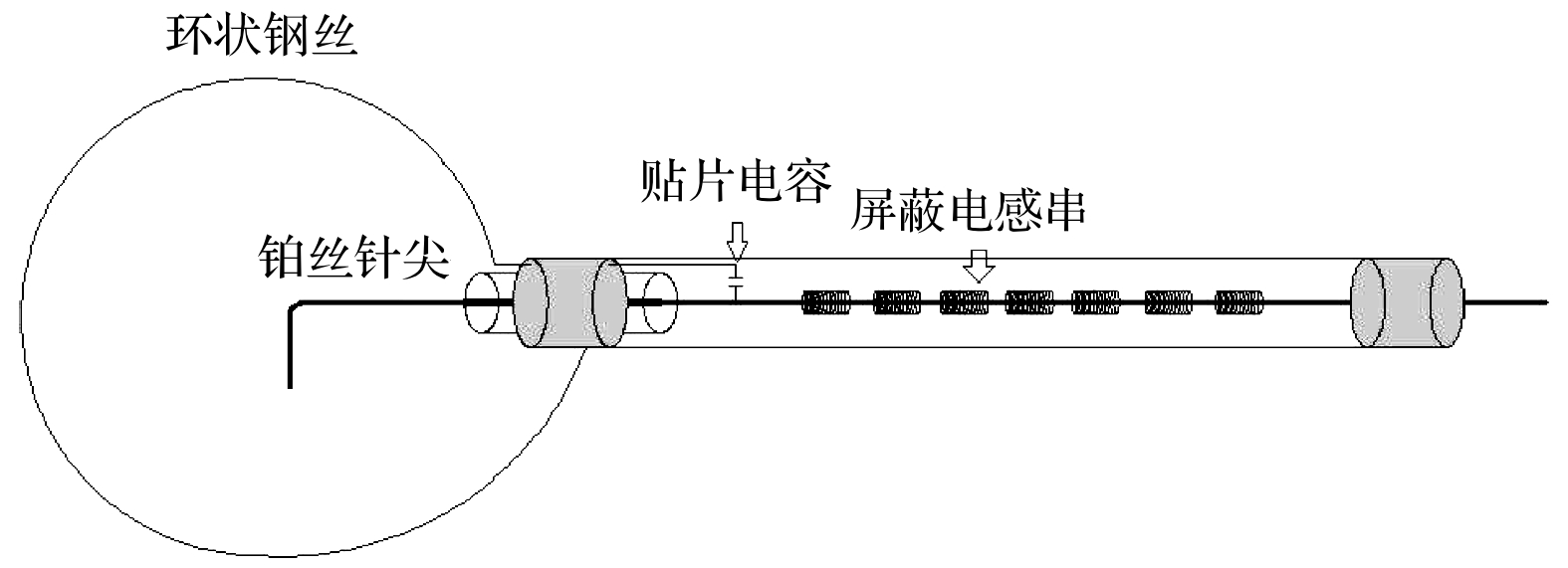 图 2 朗缪尔探针结构示意图
图 2 朗缪尔探针结构示意图














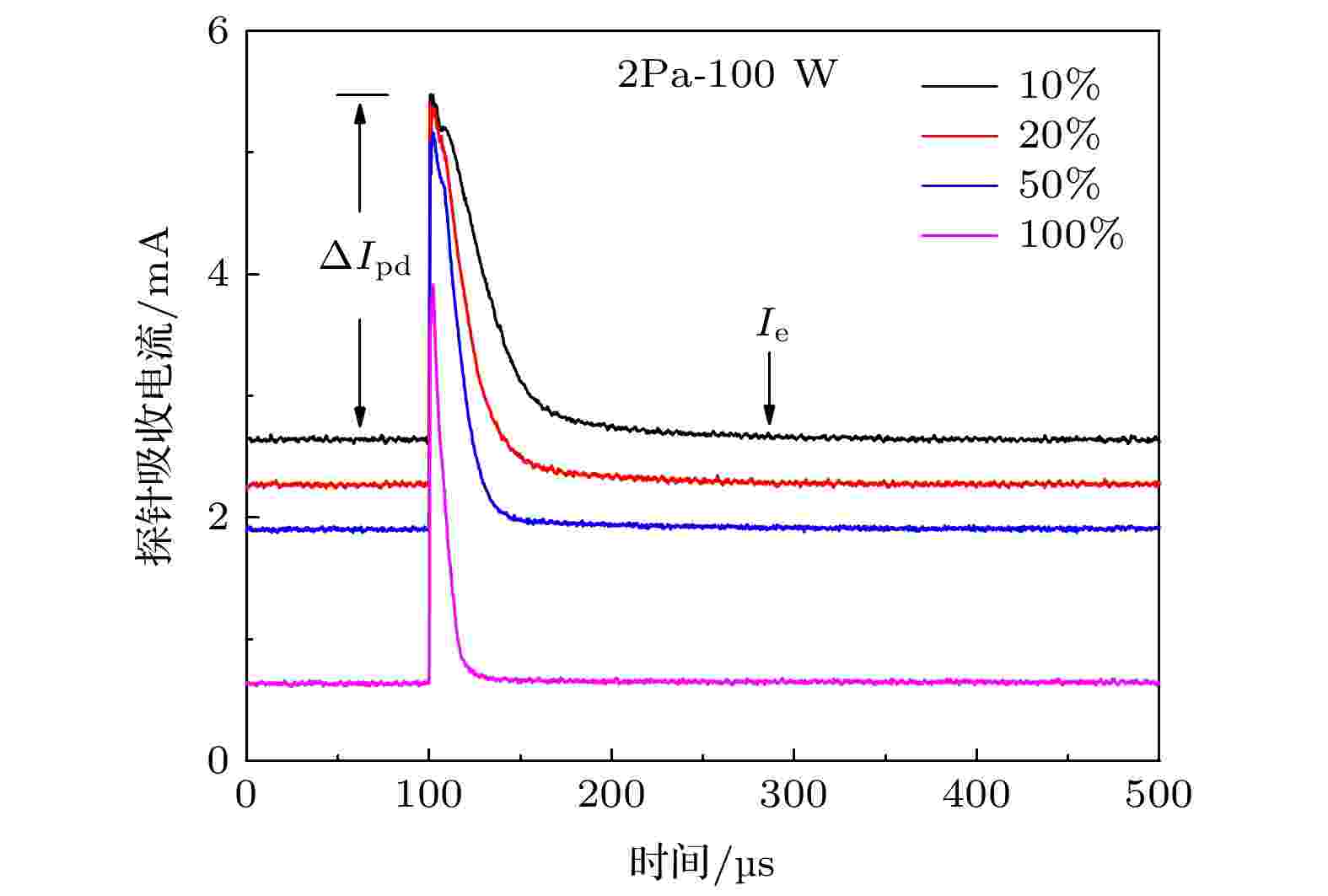 图 3 等离子体中心位置处探针测得的典型电流曲线
图 3 等离子体中心位置处探针测得的典型电流曲线




















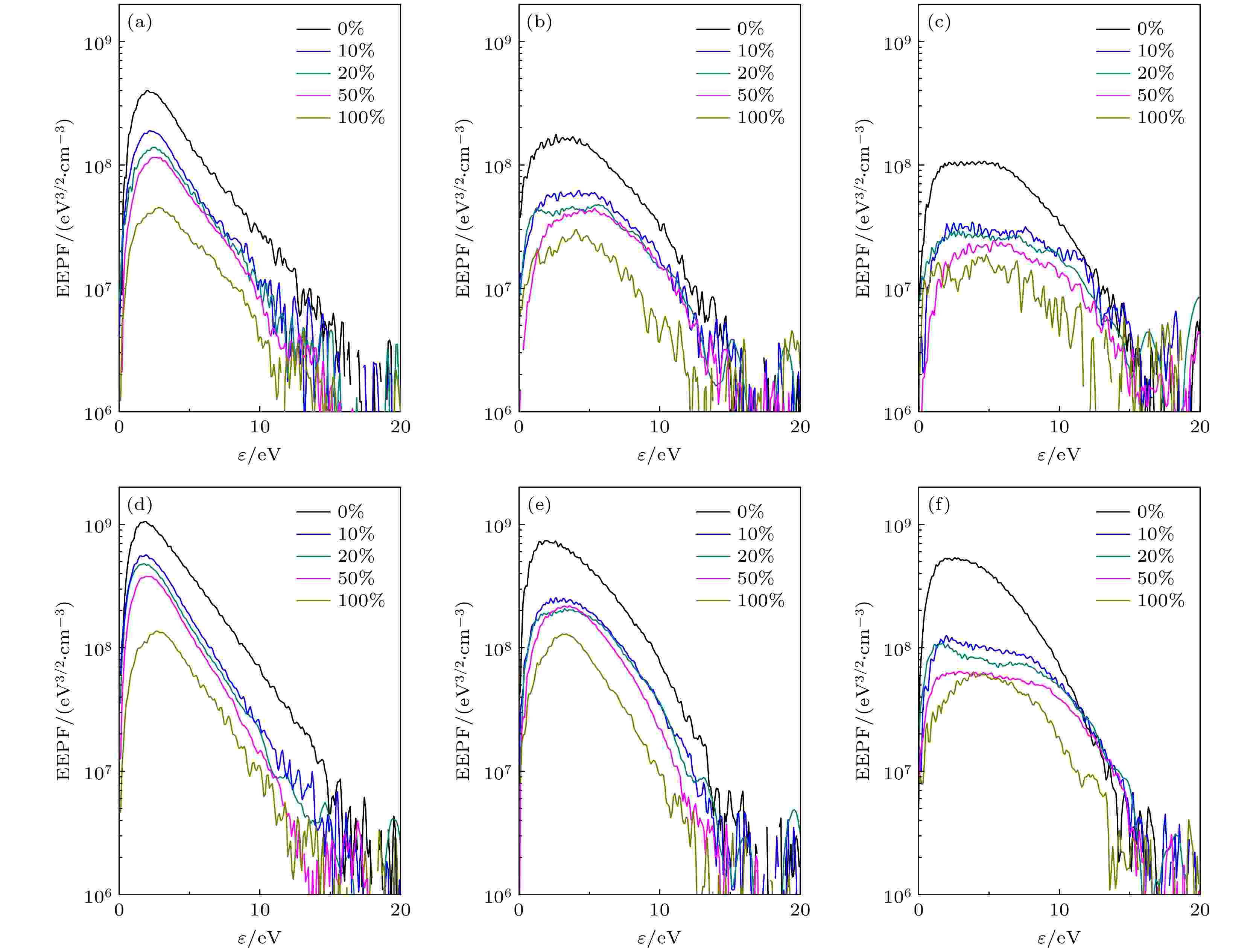 图 4 不同气压和功率条件下极板中心处EEPF随含氧量的变化情况 (a) 2 Pa-50 W; (b) 6 Pa-50 W; (c) 12 Pa-50 W; (d) 2 Pa-150 W; (e) 6 Pa-150 W; (f) 12 Pa-150 W
图 4 不同气压和功率条件下极板中心处EEPF随含氧量的变化情况 (a) 2 Pa-50 W; (b) 6 Pa-50 W; (c) 12 Pa-50 W; (d) 2 Pa-150 W; (e) 6 Pa-150 W; (f) 12 Pa-150 W








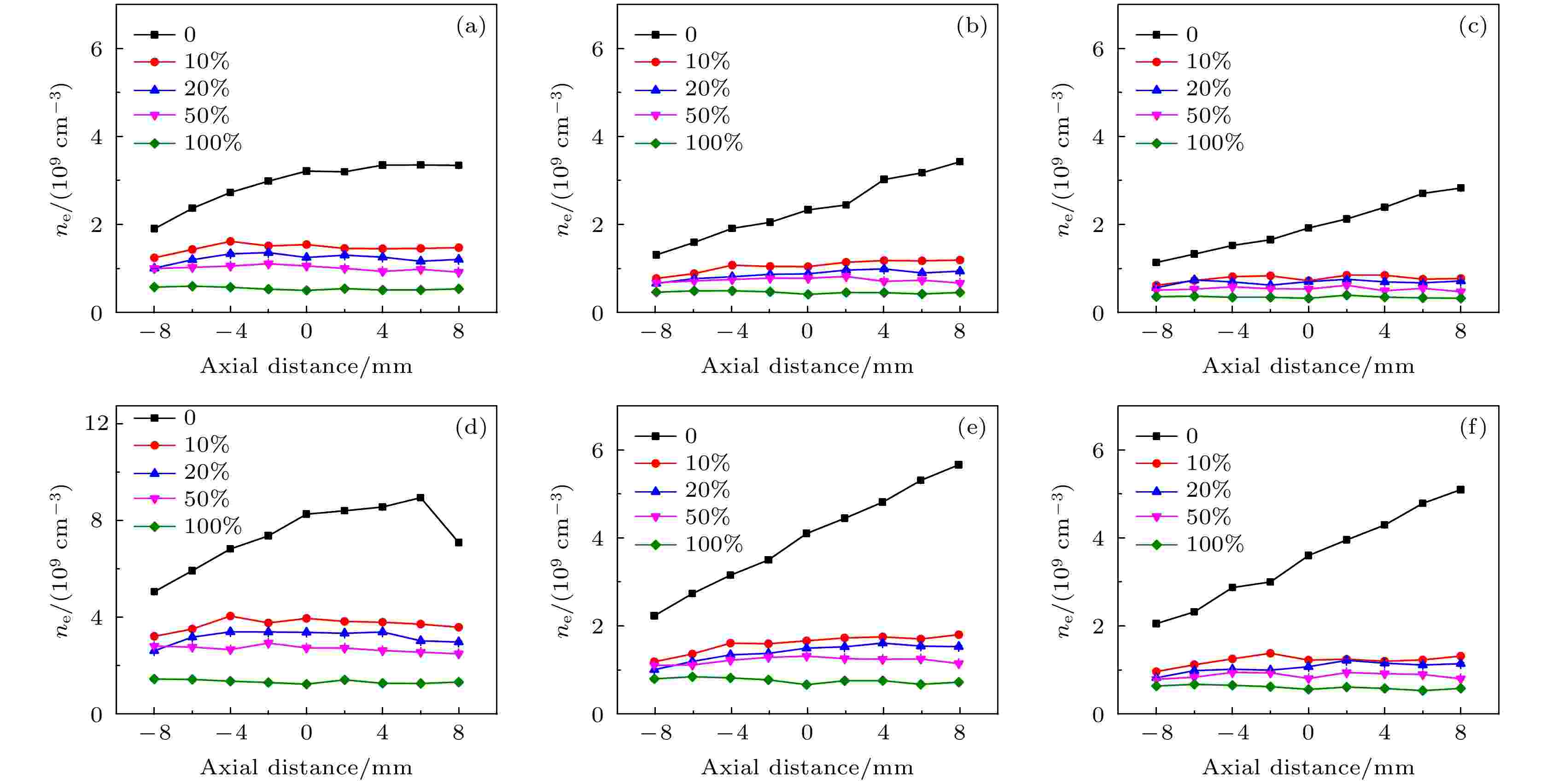 图 5 不同气压和功率条件下电子密度随含氧量的轴向分布情况 (a) 2 Pa-50 W; (b) 6 Pa-50 W; (c) 12 Pa-50 W; (d) 2 Pa-150 W; (e) 6 Pa-150 W; (f) 12 Pa-150 W
图 5 不同气压和功率条件下电子密度随含氧量的轴向分布情况 (a) 2 Pa-50 W; (b) 6 Pa-50 W; (c) 12 Pa-50 W; (d) 2 Pa-150 W; (e) 6 Pa-150 W; (f) 12 Pa-150 W
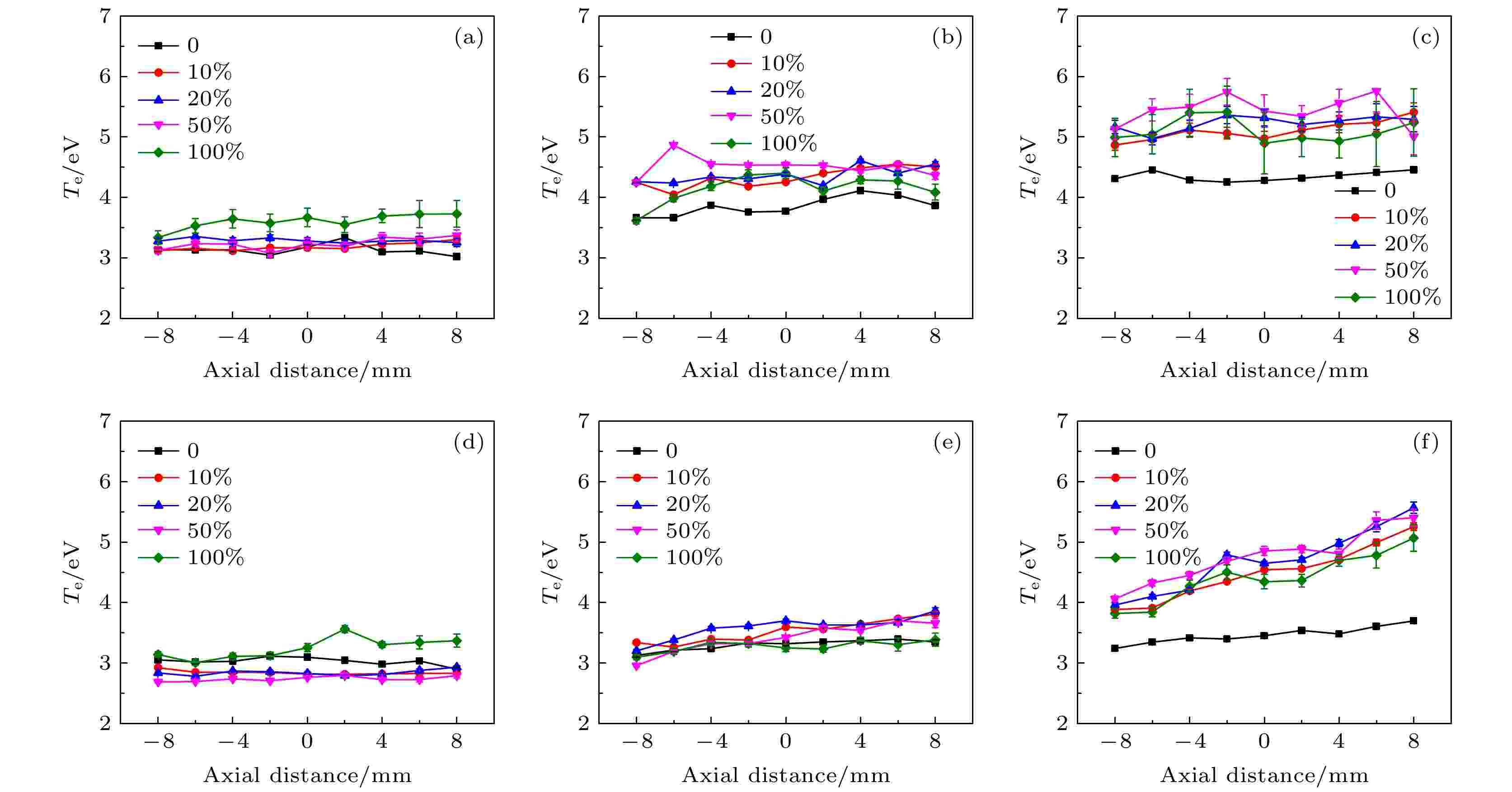 图 6 不同气压和功率条件下电子温度随含氧量的轴向分布情况 (a) 2 Pa-50 W; (b) 6 Pa-50 W; (c) 12 Pa-50 W; (d) 2 Pa-150 W; (e) 6 Pa-15 0 W; (f) 12 Pa-150 W
图 6 不同气压和功率条件下电子温度随含氧量的轴向分布情况 (a) 2 Pa-50 W; (b) 6 Pa-50 W; (c) 12 Pa-50 W; (d) 2 Pa-150 W; (e) 6 Pa-15 0 W; (f) 12 Pa-150 W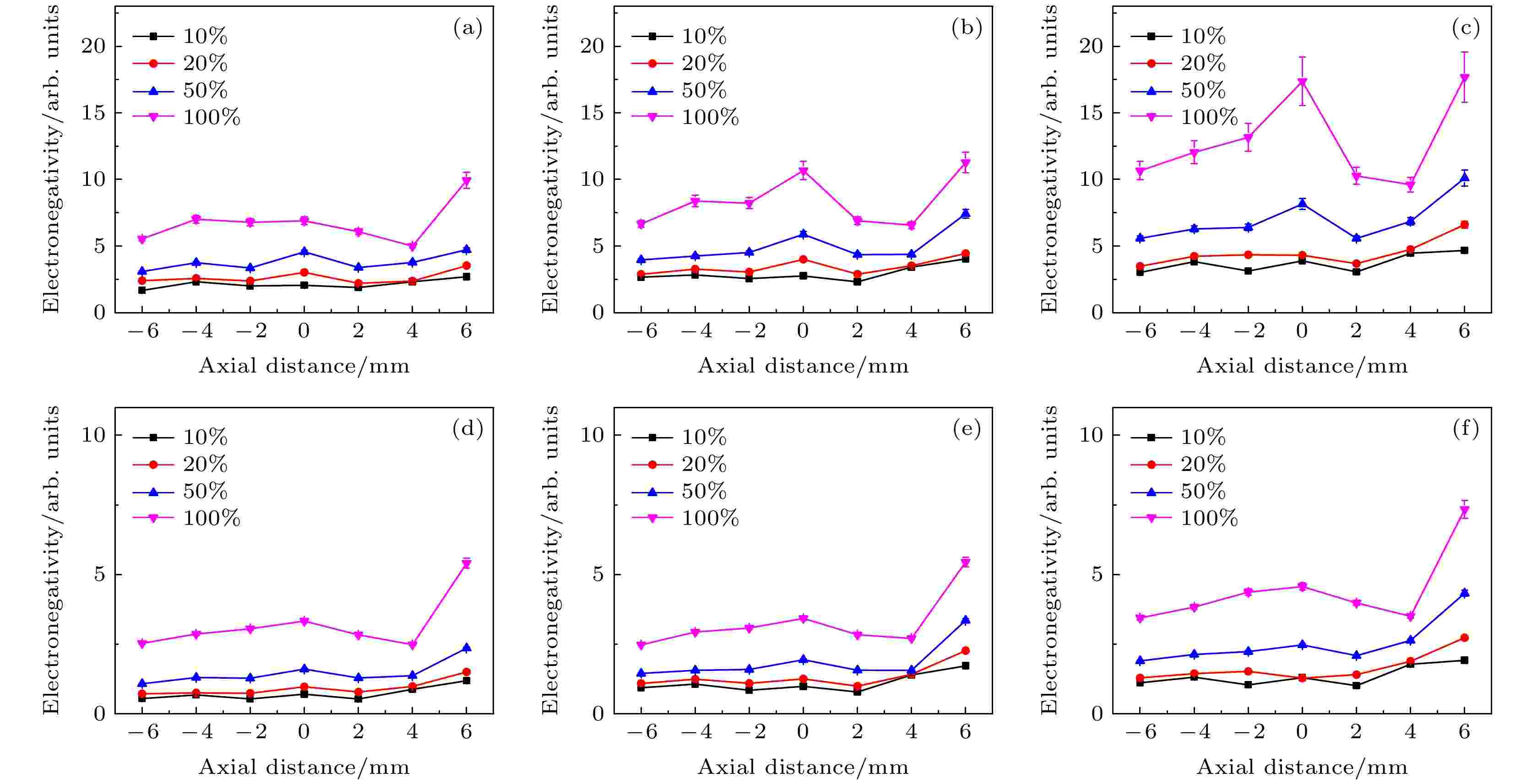 图 7 不同气压和功率条件下电负度随含氧量的轴向分布情况 (a) 2 Pa-50 W; (b) 6 Pa-50 W; (c) 12 Pa-50 W; (d) 2 Pa-150 W; (e) 6 Pa-150 W; (f) 12 Pa-150 W
图 7 不同气压和功率条件下电负度随含氧量的轴向分布情况 (a) 2 Pa-50 W; (b) 6 Pa-50 W; (c) 12 Pa-50 W; (d) 2 Pa-150 W; (e) 6 Pa-150 W; (f) 12 Pa-150 W
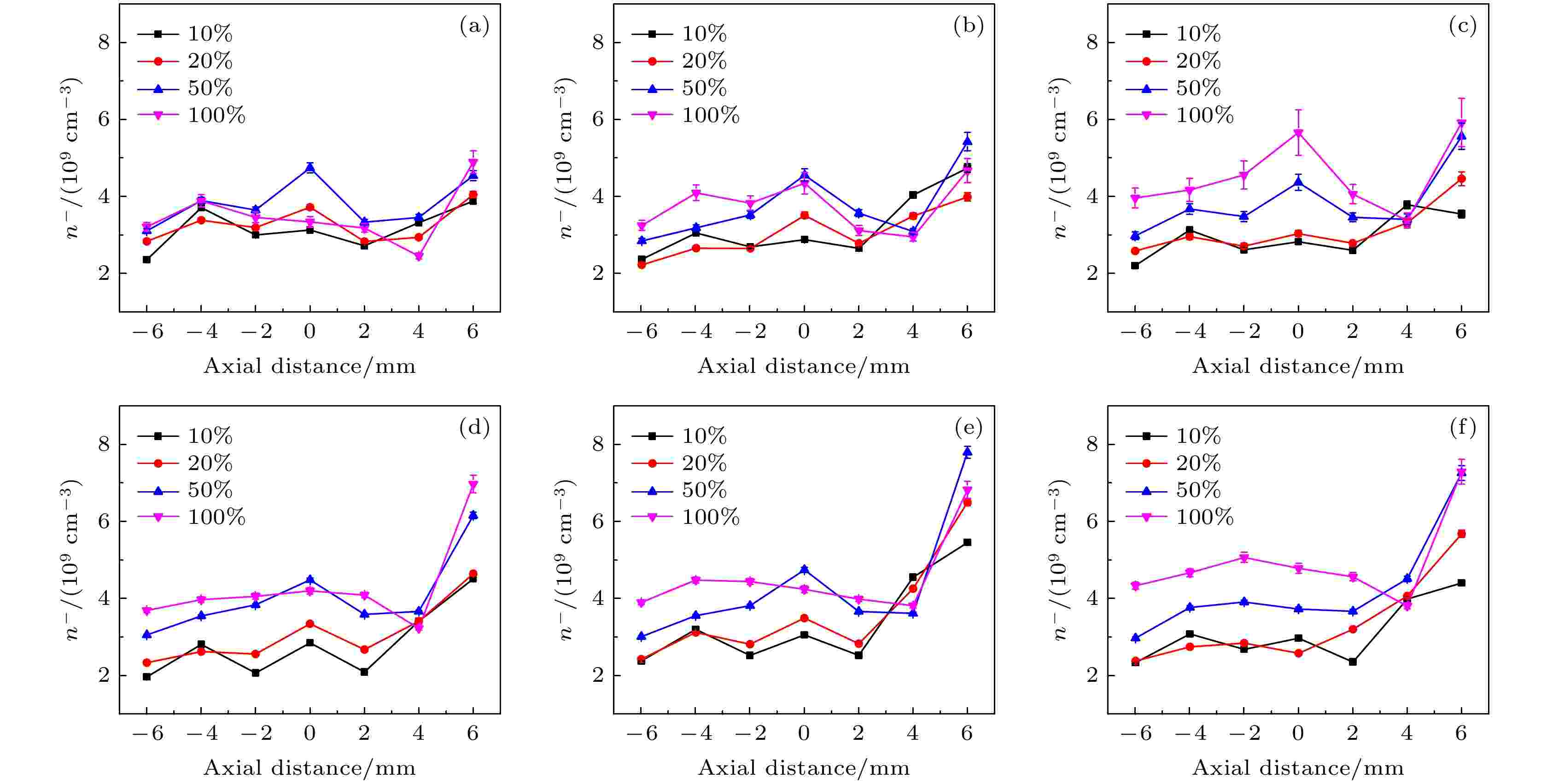 图 8 不同气压和功率条件下负离子密度随含氧量的轴向分布情况 (a) 2 Pa-50 W; (b) 6 Pa-50 W; (c) 12 Pa-50 W; (d) 2 Pa-150 W; (e) 6 Pa-150 W; (f) 12 Pa-150 W
图 8 不同气压和功率条件下负离子密度随含氧量的轴向分布情况 (a) 2 Pa-50 W; (b) 6 Pa-50 W; (c) 12 Pa-50 W; (d) 2 Pa-150 W; (e) 6 Pa-150 W; (f) 12 Pa-150 W